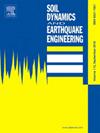Study on seismic response of a large-scale shield tunnel with an innovative loading device based on shaking table test
IF 4.2
2区 工程技术
Q1 ENGINEERING, GEOLOGICAL
引用次数: 0
Abstract
This paper presents the development of a large-scale tunnel model using an innovative loading device, which is then subjected to longitudinal seismic response analysis through a shaking table test. The loading device, designed to support the tunnel with springs, applies seismic loads from the shaking table and simulates the soil-structure interaction. Initially, the rationality and accuracy of the loading device were validated through numerical and analytical methods. Experimental results reveal that, under various seismic excitations, the acceleration response is significantly lower at the tunnel ends compared to the middle. The tensile strain response at the arch waist exhibits a U-shaped deformation along the longitudinal axis, while the compressive strain response exhibits a bending deformation with multiple inflection points. Furthermore, both tensile and compressive strain responses at the arch bottom show more pronounced bending deformations along the longitudinal direction. The findings indicate that the peak value of the input seismic excitation does not alter the deformation pattern of the tunnel. Within the longitudinal length L of the tunnel, the tensile zone reaches a maximum strain value εmax, whereas the compressive zone reaches a minimum strain value εmin. These experimental insights offer valuable references for the seismic design of tunnels.
基于振动台试验的创新加载装置对大型盾构隧道地震响应的研究
本文介绍了利用创新加载装置开发大型隧道模型的情况,然后通过振动台试验对该模型进行纵向地震响应分析。加载装置设计成用弹簧支撑隧道,施加来自振动台的地震载荷,模拟土体与结构之间的相互作用。最初,通过数值和分析方法验证了加载装置的合理性和准确性。实验结果表明,在各种地震激励下,隧道两端的加速度响应明显低于中间。拱腰处的拉应变响应沿纵轴呈 U 形变形,而压应变响应则呈多拐点弯曲变形。此外,拱底处的拉伸和压缩应变响应沿纵向都表现出更明显的弯曲变形。研究结果表明,输入地震激励的峰值不会改变隧道的变形模式。在隧道纵向长度 L 范围内,拉伸区达到最大应变值 εmax,而压缩区达到最小应变值 εmin。这些实验结论为隧道的抗震设计提供了宝贵的参考。
本文章由计算机程序翻译,如有差异,请以英文原文为准。
求助全文
约1分钟内获得全文
求助全文
来源期刊

Soil Dynamics and Earthquake Engineering
工程技术-地球科学综合
CiteScore
7.50
自引率
15.00%
发文量
446
审稿时长
8 months
期刊介绍:
The journal aims to encourage and enhance the role of mechanics and other disciplines as they relate to earthquake engineering by providing opportunities for the publication of the work of applied mathematicians, engineers and other applied scientists involved in solving problems closely related to the field of earthquake engineering and geotechnical earthquake engineering.
Emphasis is placed on new concepts and techniques, but case histories will also be published if they enhance the presentation and understanding of new technical concepts.
 求助内容:
求助内容: 应助结果提醒方式:
应助结果提醒方式:


